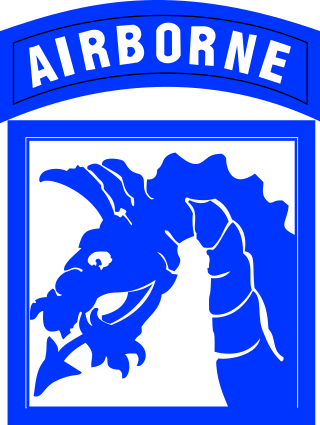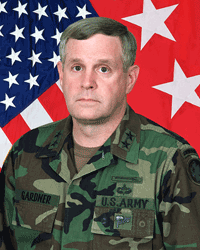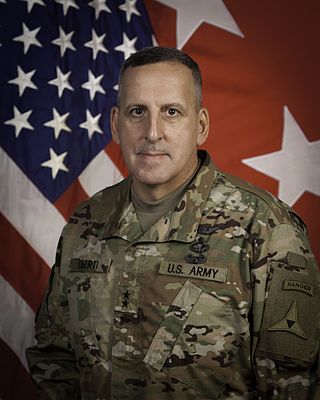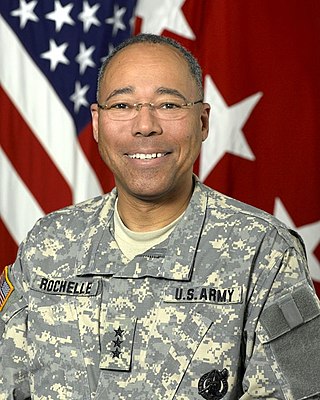
The XVIII Airborne Corps is a corps of the United States Army that has been in existence since 1942 and saw extensive service during World War II. The corps is designed for rapid deployment anywhere in the world and is referred to as "America's Contingency Corps." Its headquarters are at Fort Liberty, North Carolina.

The commanding officer (CO) or commander, or sometimes, if the incumbent is a general officer, commanding general (CG), is the officer in command of a military unit. The commanding officer has ultimate authority over the unit, and is usually given wide latitude to run the unit as they see fit, within the bounds of military law. In this respect, commanding officers have significant responsibilities, duties, and powers.

John William "Jack" Vessey Jr. was a career officer in the United States Army. He attained the rank of general, and was most notable for his service as the tenth chairman of the Joint Chiefs of Staff.

Lieutenant General Michael David Maples, USA served as the 16th Director of the Defense Intelligence Agency (DIA), appointed on November 4, 2005. He was promoted to lieutenant general on November 29. Maples also commanded the Joint Functional Component Command for Intelligence, Surveillance and Reconnaissance (JFCC-ISR) for the United States Strategic Command (USSTRATCOM). He transferred his Directorship of the Defense Intelligence Agency and his command of JFCC-ISR to LTG Ronald Burgess on March 18, 2009. Maples formally served as the vice director of management of the Joint Staff.

William Michael Steele is a retired United States Army lieutenant general who commanded major organizations including U.S. Army, Pacific, the Combined Arms Center and the 82d Airborne Division. A native of Atlanta, Georgia, he graduated from The Citadel in 1967 and earned a Master of Arts in management from Webster University in St. Louis. His military education includes the National War College.

Lieutenant General Kevin T. Campbell was the commander of the U.S. Army Space and Missile Defense Command from December 2006 to December 2010, replacing Lieutenant General Larry J. Dodgen. In October 2011 Campbell began working for Northrop Grumman Corporation as vice president and corporate lead executive (CLE) for company business after retiring from the Army.

John Donovan "Jack" Gardner is a retired lieutenant general in the United States Army. He is the former deputy commander of the United States European Command in Stuttgart, Germany. During his career he served in Europe, Asia, Latin America, Bosnia, Iraq and numerous locations throughout the United States. He currently serves as the director of the 21st Century Jobskills Project, a nonprofit organization focused on assisting public school students in transitioning to living wage jobs. Gardner is a native of Columbus, Ohio.

Major General John Uberti is a retired military officer who last served as the deputy commanding general for operations for the U.S. Army's III Armored Corps at Fort Hood, Texas.

Benjamin C. Freakley is a retired United States Army lieutenant general. From Woodstock, Virginia, Freakley was commissioned as an infantry officer in 1975, and served in Operation Desert Storm, Operation Iraqi Freedom, and Operation Enduring Freedom – Afghanistan before retiring in 2012. After leaving active duty military service, he joined the McCain Institute and Arizona State University.
The following Confederate States Army units and commanders fought in the final military encounter of the American Civil War, the 1865 Appomattox campaign, which lasted from March 29 to April 9 and resulted in Confederate surrender on April 9 at the Appomattox Court House. Order of battle has been compiled from the army organization during the campaign. The Union order of battle is listed separately.

Lieutenant General Sean Barry MacFarland is a retired three-star general who served in the United States Army.

Michael D. Rochelle is a retired United States Army lieutenant general, who served as deputy chief of staff, G-1 in the Department of the Army.

John Harrison Miller is a highly decorated retired lieutenant general in the United States Marine Corps. A veteran of World War II, Korea and Vietnam, Miller completed his career as commanding general, Fleet Marine Force, Atlantic.

Stephen Silvasy Jr. was a major general in the United States Army who served as acting commander of United States Army Pacific in 1996. He is an alumnus of the US Military Academy and US Naval Postgraduate School. He also received military education at the Armed Forces Staff College and US Army War College.

Richard Greenleaf Trefry was a lieutenant general in the United States Army. His last assignment was Inspector General of the Army.

David Wilson is a United States Army lieutenant general who has served as the deputy chief of staff for installations of the U.S. Army since September 2024. He most recently served as the commanding general of the United States Army Sustainment Command from 2022 to 2024. He previously served as the Commanding General of 8th Theater Sustainment Command at Fort Shafter, Hawaii from 2020 to 2022. He previously served as the Director J/U-4, United States Forces Korea/United Nations Command/Deputy Director, C4 Combined Forces Command located in Camp Humphreys, Republic of Korea and as the 40th Chief of Ordnance and Commandant of the United States Army Ordnance School at Fort Lee, Virginia.

James Lawton Collins Jr. was a brigadier general in the U.S. Army who served in World War II, the Korean War and the Vietnam War, a military historian, and a viticulturist. He was the son of Major General James Lawton Collins, nephew of General J. Lawton Collins, who served as Chief of Staff of the Army during the Korean War, and older brother of Apollo 11 astronaut Major General Michael Collins. He led a North Dakota National Guard artillery battalion in Normandy in 1944, and served as the U.S. Army Chief of Military History from 1970 to 1982.

Theodore David Martin is a retired lieutenant general in the United States Army who last served as the commanding general of the United States Army Combined Arms Center, commandant of the United States Army Command and General Staff College and commanding general of Fort Leavenworth from May 2021 to October 2022. Before that, he served as the Deputy Commanding General and Chief of Staff of United States Army Training and Doctrine Command (TRADOC). A graduate of the United States Military Academy at West Point, he previously served as its 73rd Commandant of Cadets.

Robert Burneston Luckey was a decorated officer in the United States Marine Corps with the rank of lieutenant general. A veteran of several wars, Luckey completed his career as commanding general, Fleet Marine Force, Atlantic.

John Austin Dubia was a lieutenant general in the United States Army who last served as Director of the Army Staff from 1995 to 1999. He was also executive vice president of AFCEA International until September 2013.






















